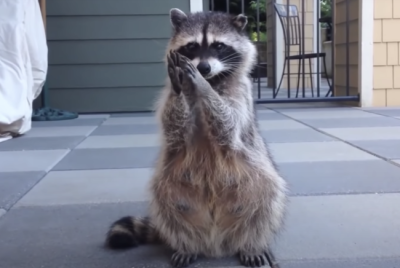Identification
Since raccoons are nocturnal mammals, you can hardly spot them moving around in the daytime. The fact that you can’t see the raccoons at daytime doesn’t stop you from noting the presence of the bandits in your home.
Instead, you can use sounds, tracks they leave behind, poop, and most probably, the damage they cause. Let’s delve deep into these identifiers.
Raccoon Sounds
Raccoons have different sounds for different occasions. Some of these sounds include:
Vocal Noise:
Raccoons interact with over 200 types of sounds. However, the sound effects vary according to the activities. For instance, they have distinctive movement sounds such as rustling and scurrying.
Besides movement noise, these bandits also use a wide range of sounds to communicate with each other. Such sounds include:
- Chattering
- Purring
- Growling
- Snarling
- Hissing
- Whimpering
- Screeching, among others.
Baby raccoons tend to produce different sounds to express different types of needs and responses. Below are some of the common sounds that you can use to know baby raccoons are around.
- Whining
- Crying
- Mewing
Movement Noise:
These are the sounds they make while in motion, especially during the night.
They produce sounds through physical movements, when they sleep, or when forcing entry into a hole or an opening. These sounds include but are not limited to:
- Rustling
- Scurrying
Raccoon poop:
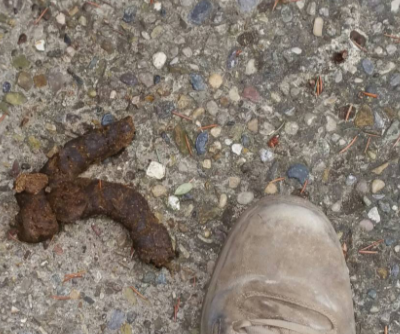
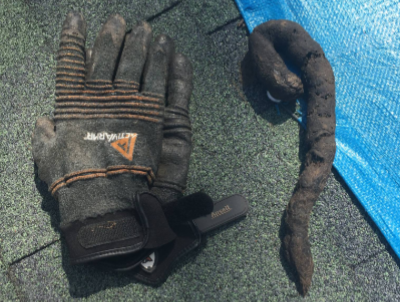
Examining the strange poop left behind in the attic or any other part of your home is one of the reliable ways of identifying the raccoons’ presence.
Even though other animal pests may leave behind their poop, the following characteristics will make you identify the raccoons’ poop instantly.
Poop appearance: Raccoon droppings look like tubes with blunt ends. They are mostly black, but change with the type of food they have consumed.
Latrines: Raccoons create individual toilets that they usually use to defecate once they invade an area.
These latrine types are consistent, and you can find them on rooftops, woodpiles, attics, and haylofts or stores. Interestingly, the latrines contain mixed poop, from old to fresh.
Undigested food: it is effortless to differentiate a raccoon poop and that of a dog. Raccoon poop contains partly undigested food particles. Most of the time, this undigested food is wild berries.
Smell: Raccoon poop has a pungent smell. Therefore, you can effortlessly notice the presence of the poop from a distance.
Dangers associated with raccoon poop
Apart from the pungent smell, raccoon poop might contain some deadly pathogens. Therefore, ensure you’re in full protective gear before handling them. Some of the dangers associated with raccoon poop include:
Roundworm eggs: Their feces might contain thousands of roundworm eggs that are dangerous to both human beings and domestic animals if taken.
Diseases: These feces might contain deadly diseases that might harm human beings and pets.
Smell: Raccoon poop has a foul odor. Once mixed with their urine, the smell may cause discomfort to people nearby.
When you come across raccoon poop within the compound or in the attic, you should dispose of it immediately using available safety means.
Raccoon Tracks:
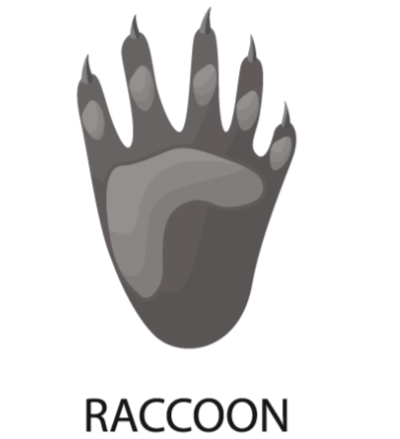
Observing tracks is one of the best ways of identifying the presence of raccoons. With their five-finger paws, they leave prints resembling that of children's hands.
Their front and rear paws have five fingers protruding on their C-shaped palms.
They have a distinctive walking gait, which they use while walking and also during foraging. Steps vary from 10 to 18 Inches.
When scared, they also use lopes and gallops while running to avoid danger. Their innermost toe is always smaller, and very far from the rear of the foot as compared to other toes. This allows the left and the right tracks to be differentiated easily by observing the print.
Noting raccoons’ tracks is pretty straight forward as they always walk through mud. You can find their prints on top of the table or on car tops in the car park.
Raccoon Damage:
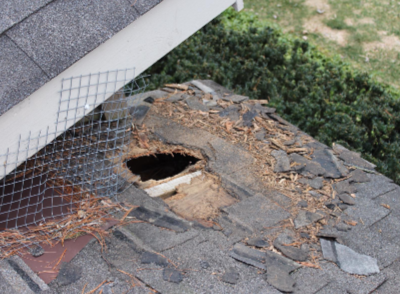
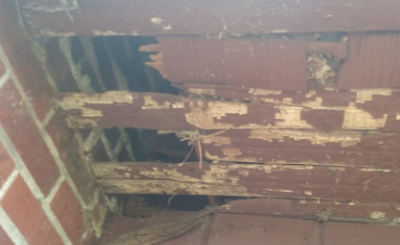
Once they invade a home or farm, raccoons can cause massive damage if not controlled quickly. This could include:
Destroying plants and vegetables: These animals feed on vegetables, which include corn, watermelons, and sweet berries.
Once they invade your garden, they will eat and destroy any kind of plant which they deem edible.
Eating chickens and eggs: once they find their way into chicken shelters, raccoons kill and eat the chickens, including their eggs.
Rip off ducts: Raccoons rip off tubes, most probably to find materials to build up their nests or just to check what is inside, especially when they land on attics.
Interfere with installations: Raccoons chew off electrical wires, gnaw into water pipes, or move and misplace loosely placed light objects.
Poop: Their poop is always dangerous and a health risk to both human and domestic animals. Sometimes, it becomes difficult to locate the poop, making the air conditions unfavorable before discovering where it is.
Lousy smell: With their smelly poop and urine, Raccoons create an awful smell once they invade a place. Some of them end up dying on pipes and ventilation holes.
These decomposing bodies may make a place inhabitable due to the foul smell.
Create a mess: With their movements and destructive nature, they will always leave a mess once they invade an area. They make surfaces dirty, with particles and half-eaten plants thrown all over the place.
Spread diseases: with their poop, urine, and movements, these animals may spread an infection from one area to another. They also transfer parasites like roundworms and others from one area to another.
Noise: Their movements and sounds are a nuisance, especially during the night when they are active. They can cause sleepless nights to homeowners and neighborhoods.
Rabies: Raccoons carry the disease on their bodies, which are harmful to both human beings and domestic animals. They can spread this rabies from one area to another as it sticks within their fur.
